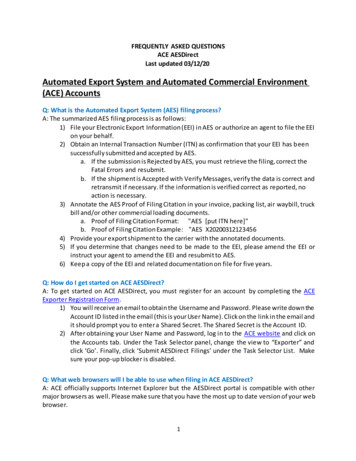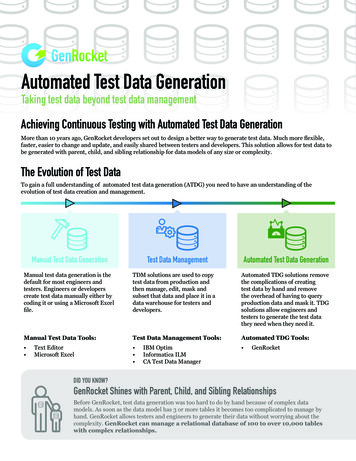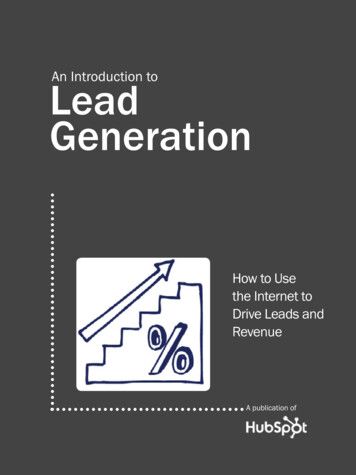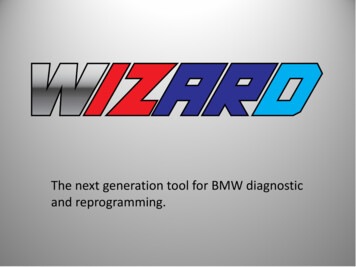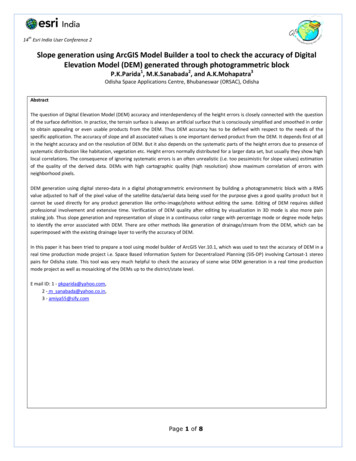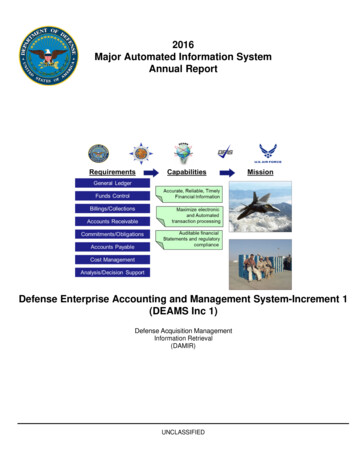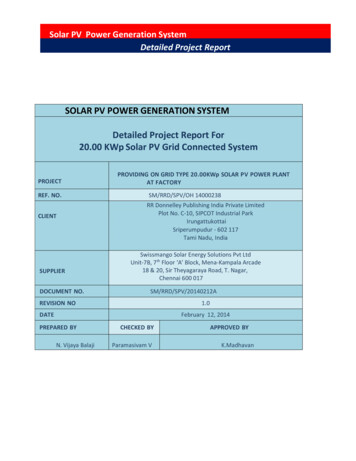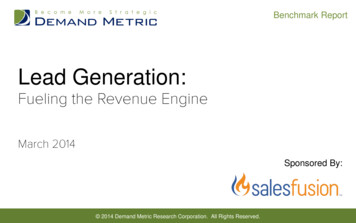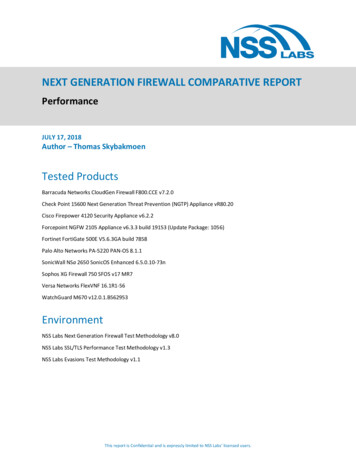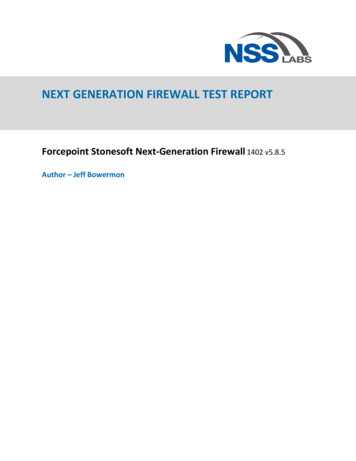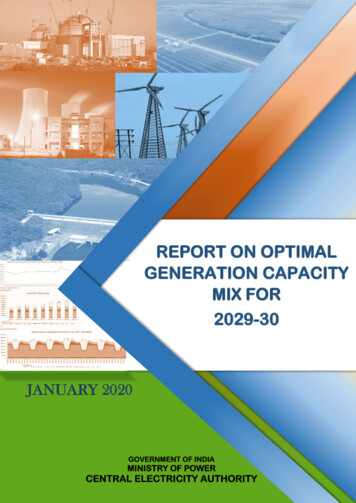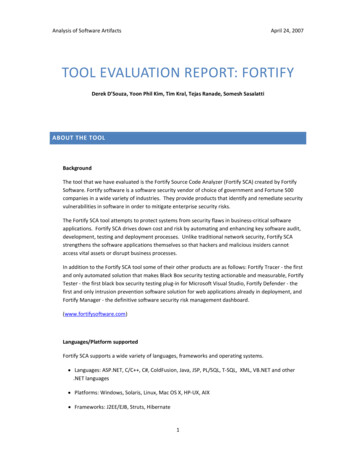
Transcription
Publication 10An Automated Report Generation Tool for the DataUnderstanding PhaseJuha Vesanto and Jaakko HollménIn Hybrid Information Systems, edited by A. Abraham and M.Köppen, Physica Verlag, Heidelberg, pp. 611-626, 2002.
Copyright 2002 Springer-Verlag.An Automated Report Generation Tool for the DataUnderstanding PhaseJuha Vesanto and Jaakko HollménHelsinki University of TechnologyLaboratory of Computer and Information ScienceP.O. Box 5400, FIN-02015 HUT, FinlandJuha.Vesanto@hut.fi, Jaakko.Hollmen@hut.fiAbstract To prepare and model data successfully, the data miner needs to be aware of theproperties of the data manifold. In this paper, the outline of a tool for automatically generatingdata survey reports for this purpose is described. The report combines linguistic descriptions(rules) and statistical measures with visualizations. Together these provide both quantitativeand qualitative information and help the user to form a mental model of the data. The main focus is on describing the cluster structure and the contents of the clusters. The data is clusteredusing a novel algorithm based on the Self-Organizing Map. The rules describing the clustersare selected using a significance measure based on the confidence on their characterizing anddiscriminating properties.1 IntroductionThe purpose of data mining is to find knowledge from databases where the dimensionality, complexity, or amount of data is prohibitively large for manual analysis. This is an interactive process which requires that the intuition and backgroundknowledge of application experts are coupled with the computational efficiency ofmodern computer technology.The CRoss-Industry Standard Process for Data Mining (CRISP-DM) [4] dividesthe data mining process to several phases. One of the first phases is data understanding, which is concerned with understanding the origin, nature and reliability of thedata, as well as becoming familiar with the contents of the data through data exploration. Understanding the data is essential in the whole knowledge discoveryprocess [17]. Proper data preparation, selection of modeling tools and evaluationprocesses is only possible if the miner has a good overall idea, a mental model, ofthe data.The data exploration is usually done by interactively applying a set of data exploration tools and algorithms to get an overview of the properties of the data manifold.However, understanding a single data set — a specific collection of variables andsamples — is often not enough. Because of the iterative nature of the knowledgediscovery process, several different data sets and preprocessing strategies need tobe considered and explored. The task of data understanding is engaged repeatedly.Therefore, the tools used for data understanding should be as automated as possible.
REPORTdatapreparationanalysisreportingvariable analysiscluster analysisvisualizationsdescriptionssummary tableslistsinteractiveprocessingmodelsFigure1. Data understanding as an iterative process. The data is prepared and fed into theanalysis system which generates the data survey report. Based on the findings in the reportand possibly further insights based on interactive investigation, the data miner may eitherproceed with the next data mining phase, or prepare the data set better and, with a push of abutton, make a new report. The area within the dashed box corresponds to the implementedsystem.1.1 Automated analysis of table-format dataThis paper presents a selection of techniques and associated presentation templatesto automate part of the data understanding process. The driving goal of the work hasbeen to construct a framework where an overview and initial analysis of the datacan be executed automatically, without user intervention. The motivation for thework has come from a number of data mining projects, in process industry for example [1], where we have repeatedly encountered the data understanding task whenboth new data sets and alternate preprocessing strategies have been considered.While statistical and numerical program packages provide a multitude of techniques that are similar to those presented here, the novelty of our approach is tocombine the techniques and associated visualizations into a coherent whole. In addition, using such program packages requires considerable time and expertise. Anautomated approach used in this paper has a number of desirable properties: the analysis is easy to execute again (and again and .), the required level of technical know-how of the data miner is reduced whencompared to fully interactive data exploration, and the resulting report acts as documentation that can be referred to later.Of course, an automatically performed analysis can never replace the flexibility andpower inherent in an interactive approach. Instead, we consider the report generationsystem described here to provide an advantageous starting point for such interactiveanalysis, see Figure 1.The nature of the report generation system imposes some requirements for theapplied methods. The algorithms should be computationally light, robust, and require no user-defined parameters. They should also be generic enough so that theirresults are of interest in most cases. Naturally, what is interesting depends on theproblem and the data domain. In the implemented system, the domain has been restricted to unsupervised analysis of numerical table-format data, see Figure 2. In
Data samplesVariablesFigure2. Table-format data can be investigated both in terms of samples and in terms of variables. Samples are analyzed to find clusters or groups of similar items (Section 2). Variablesare analyzed to find groups of related items (Section 3).contrast, supervised estimation of one or more output variables, analysis of purelycategorical variables, and analysis of data sequences or time-series are not considered.However, simply applying the analysis algorithms to the data is not enough:the knowledge must be transferred to the data miner. This is accomplished througha data survey report. The report consists of a short overview for a quick look atthe major properties of the data, followed by a more detailed description of eachvariable and cluster. The elements of the report are visualizations and numerical orlinguistic descriptions organized into summary tables and lists. Visualizations area very important part of the report since they allow the display of large amountsof detailed information in a coherent manner, and give the data miner a chance tovalidate the quantitative descriptions with respect to the actual data [21].1.2 Related workIn [17], Pyle introduces the concept of data survey for getting a feel of the datamanifold. The emphasis is on variable dependency analysis using entropy and related measures, and on identifying problems in the data. Unfortunately, only rathergeneral guidelines are given, and cluster analysis is handled very briefly.Cluster analysis, and especially characterization of the contents of the clustersis one of the key issues in this paper. The clusters can be characterized by listing thevariable values typical for each cluster using, for example, characterizing rules [8].Another approach is to rank the variables in the order of significance [13,18,20]. Inthis paper, both approaches are used.In [16], a report generation system KEFIR is described. It automatically analyses data in large relational databases, and produces a report on the key findings.The difference to our work is that KEFIR compares a data set and a priori givennormative values, and tries to find and explain deviations between them, and thusrequires considerable setting up. The system described in this paper, on the otherhand, is applied when the data miner starts with a single unfamiliar data set.
In this sense, the recent work by Bay and Pazzani [2] is much closer to certainparts of this work. They examine the problem of mining contrast sets, where thefundamental problem is to find out how two groups differ from each other, andpropose an efficient search algorithm to find conjunctive sets of variables and valueswhich are meaningfully different in the two groups. The difference to our workis that they are concerned with categorical variables, and want to find all relevantdifferences between two arbitrary groups, for example between males and females.In this work, the data is numerical, and the two groups are always two clusters, or acluster and the rest of the data. This simplifies the task considerably since the itemsin the clusters are always internally similar.In the implemented system, metric clustering techniques are used, so the inputdata needs to be numerical vector-data (which may have missing values). Anotherpossibility would be to use conceptual clustering techniques [15], which inherentlyfocus on descriptions of the clusters. However, conceptual clustering techniques arerather slow, while recent advances have made metric clustering techniques applicable to very large data sets [7].1.3 Organization and example data setThe paper is organized as follows. In Section 1, the methodology and basic motivation for the implemented system has been described. In Sections 2 and 3, the analysis methods for samples and variables, respectively, are described. In Section 4, theoverall structure of the data survey report is explained. The work is summarized inSection 5.Throughout the paper, a simple real-world data set is used to illustrate the elements of the report. It describes the operation of a single computer workstation in anetworking environment. The workstation was used for daily activities of a researchscientist ranging from computationally intensive (data analysis) tasks to editing ofprograms and publications. The number of variables recorded was 9. Four of thevariables reflect the volumes of network traffic and five of them the CPU usagein relative measures. The variables for measuring the network traffic were blks(read blocks per second), wblks (written blocks per second), ipkts (the numberof input packets) and opkts (the number of output packets). Correspondingly, thecentral processing unit activities were measured with variables usr (time spent inuser processes), sys (time spent in system processes), intr (time spent handlinginterrupts), wio (CPU was idle while waiting for I/O), idle (CPU was idle andnot waiting for anything). In all, 1908 data vectors were collected.2 Sample analysisThe relevant questions in terms of samples are: Are there natural groups, i.e. clusters, in the data, and what are their properties?
2.1 ProjectionA qualitative idea of the cluster structure in the data is acquired by visualizing thedata using vector projection methods. Projection algorithms try to preserve distancesor neighborhoods of the samples, and thus encode similarity information in the projection coordinates. There are many different kinds of projection algorithms, see forexample [12], but in the proposed system, a linear projection to the plane spannedby two principal eigenvectors is used. This is because of computational efficiency,and to be able to project new data points (e.g. cluster centers) easily. It also allowsthe use of a scree plot for easily understandable validation of the projection, seeFigure 3a.Like spatial coordinates, colors can also be used to encode similarity information [27,25,10]. Instead of similar positions, data samples close to each other getsimilar colors. While the resulting similarity encoding is not as accurate as the oneproduced by spatial projection, it is useful for linking multiple visualizations together, or when the position information is needed for other purposes. In the implemented system, the colors are assigned from the hues on a color circle by a simpleprojection of cluster centroids onto the circle. These colors are used consistentlyin various visualizations throughout the report to indicate which cluster the samplebelongs to.2.2 ClusteringClustering algorithms, see for example [6], provide a more quantitative analysis ofthe natural groups that exist in the data. In real data, however, clusters are rarelycompact, well-separated groups of objects — the conceptual idea that is often usedto motivate clustering algorithms. Apart from noise and outliers, clustering maydepend on the level of detail being observed. Therefore, instead of providing a single partitioning of the data, the implemented system constructs a cluster hierarchy.This may represent the inherent structure of the data set better than a single directpartitioning. Equally important from data understanding point of view is that thehierarchy also allows the data to be investigated at several levels of granularity.In the implemented system, the Self-Organizing Map (SOM) is used for clustering [11,26]. First, the data is quantized using a SOM with a few hundred mapunits. After this the map units are clustered. This is done based on the U-matrix [23]technique which is, in effect, a measure of the local probability density of the datain each map unit. Thus, the local minima of the U-matrix — map units for whichthe distance matrix value is lower than that of any of their neighbors — can be usedto identify cluster centers, as done in [24]. We use an enhanced version based onregion-growing:1. The local minima in the distance matrix are found.2. Each local minima is set to be one cluster: C i mi . All other map units m jare left unassigned.3. The distances d Ci m j from each cluster Ci to (the cluster formed by) eachunassigned map unit m j are calculated.
4. The unassigned map unit with smallest distance is found and assigned to thecorresponding cluster.5. Continue from step 3 until all map units have been assigned.This procedure provides a partitioning of the map into a set of c base clusters,where c is the number of local minima on the distance matrix. Overall, this 2-phasestrategy reduces the computational complexity of the clustering considerably because only a few hundred objects need to be clustered instead of all the original datasamples [26]. In addition, the SOM is useful as a convenient projection of the datacloud, see Section 3.Starting from the base clusters, some agglomerative clustering algorithm is usedto construct the initial cluster hierarchy. Agglomerative clustering algorithms startfrom some initial set of c clusters and successively join the two clusters closest toeach other (in terms of some distance measure), until there is only one cluster left.This produces a binary tree with 2c 1 distinct clusters. Since the binary structuredoes not necessarily reflect the properties of the data set, a number of the clusters inthe initial hierarchy will be superfluous and need to be pruned out. This can be doneby hand using some kind of interactive tool [3], or in an automated fashion usingsome cluster validity index. In the implemented system, the following procedure isapplied:1. Start from root cluster.2. For the cluster under investigation, generate different kinds of sub-cluster setsby replacing each cluster in the sub-cluster set by its own sub-clusters.3. Each sub-cluster set defines a partitioning of the data in the investigated cluster.Investigate each partitioning using Davies-Bouldin index:IDB i j1 nmaxn i d i j j i 1 (1) where n is the number of clusters in the sub-cluster set, i is internal dispersionof sub-cluster i and d i j is the distance between sub-clusters i and j [5]. Theindex gets low values for well-separated and compact clusters.4. Select the sub-cluster set with minimum value for I DB , and prune the corresponding intermediate clusters.5. Select an uninvestigated and unpruned cluster, and continue from step 2.In Figure 3b, the clusters and cluster hierarchy are presented using dendrogramswhich are linked with the projection results using projection coordinates. In theactual report, colors are used to provide a much more efficient linking.2.3 Cluster characterizationDescriptive statistics — for example means, standard deviations and histograms ofindividual variables — can be used to list the values typical for each cluster. Notall variables are equally interesting or important, however. Interestingness can be
DendrogramDendrogram projectioneigenvalues2D linear projection0.9591080.82775604 52 100 15050101 2 3 4 5 6 7 8 9(a)(b)Figure3. Projection visualization (a) and cluster hierarchy (b). The projection gives an idea ofthe shape of the data manifold. It is accompanied by the scree plot of cumulative eigenvalues.This gives an idea of the inherent dimensionality of the data set, and the reliability of the2-dimensional projection. In this case, the projection covers 83% of the total variance. In(b), the cluster hierarchy is visualized using a dendrogram. The figure on the right links thedendrogram to the projection visualization by showing the dendrogram starting from the 2dimensional projection coordinates. In the actual report, the linking is further enhanced bycoloring each data sample with the color of the (base) cluster it belongs to.defined as deviation from the expected [16,9]. It can be measured for each cluster asthe difference between distributions of variable values in the cluster versus the wholedata either using probability densities or some more robust measures, for examplestandard or mean deviation. Each cluster can then be characterized by using a list ofthe most important variables and their descriptive statistics.Another frequently employed method is to form characterizing rules [22] to describe the values in each cluster:Ri : x Ci xk αk βk (2)where xk is the value of variable k in the sample vector x, C i is the investigatedcluster, and αk βk is the range of values allowed for the variable according to therule. These rules may concern single variables like R i above, or be conjunctions ofseveral variable-wise rules in which case the rule forms a hypercube in the inputspace.The main advantage of such rules is that they are compact, simple and therefore easy to understand. The problem is of course that clusters often do not coincidewell with the rules since the edges between clusters are not necessarily in parallelwith the edges of the hypercube. In addition, the cluster may include some uncharacteristic points or outliers. Therefore the rules should be accompanied by validityinformation. The rule R i can be divided to two different cases, a characterizing and
0000C CabRcd RFigure4. The correspondence between cluster C and rule R. The cluster is the verticallyshaded area, and the rule (or classification model) is the horizontally shaded area. On theright is the corresponding confusion matrix: a is the number of samples which are in the cluster, and for which the rule is true. In contrast, d is the number of samples which are out of thecluster, and for which the rule is false. Ideally, the off-diagonal elements in the matrix shouldbe zero.a differentiating rule:Rci : x Ci xk αk βk Rdi : xk αk βk x Ci The validity of R i with respect to each case can be measured using confidence:Pic P xk αk βk Ci and Pid P Ci xk αk βk , respectively.To form the rules — in effect to select the variables and associated values forαk and βk for each rule — one can use statistics of the values in the clusters, asin [22]. Another approach is to optimize the rules with respect to their significance.The optimization can be interpreted as a two-class classification problem betweenthe cluster and the rest of the data. The boundaries in the characterizing rule canbe set by maximizing a function which gets its highest value when there are nomiss-classifications, for example: a ab dc daas2 a b a
An Automated Report Generation Tool for the Data Understanding Phase Juha Vesanto and Jaakko Hollm en Helsinki University of Technology Laboratory of Computer and Information Science P.O. Box 5400, FIN-02015 HUT, Finland Juha.Vesanto@hut.fi, Jaakko.Hollmen@hut.fi Abstract To prepare an
